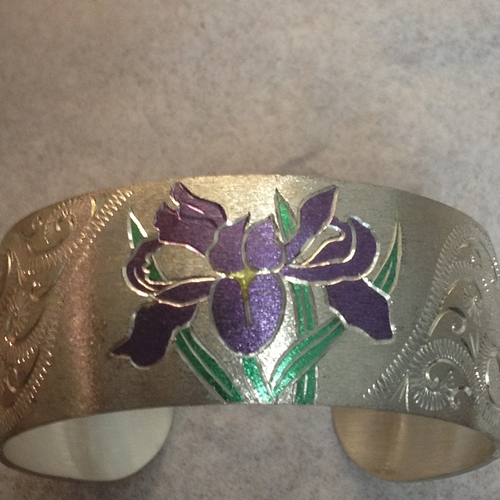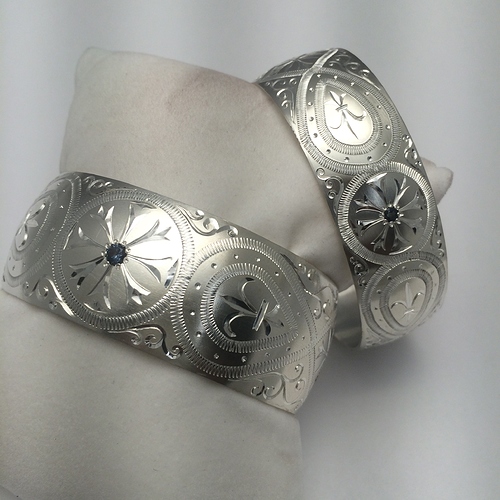Hello -
I’m considering E-coating to prevent sterling silver and plated jewelry from tarnishing. I understand that its life depends on how jewelry is cared, but if an e-coated necklace is worn daily without too much abuse, how many months/years does the coating typically last before it starts tarnishing? What is your experience?
I also would like to know:
- Whether E-coating coats a fine (link size under 2mm) chain well. I currently use an anti-tarnish dipping solution, but it makes a treated chain stiff.
- Whether or not I can E-coat multiple pieces of components at a time. Or if it’s possible to coat finished jewelry that consists of several charms, jump rings, and a chain. I currently need to clean and dip components one by one, and it takes too much time.
Thank you very much.
Megu
For what it’s worth!
There is a gold-plating company in Toronto that plates rings for jewellry
companies & watch-covers for some upscale mfgr’s. I asked him just how
thick his plating is…The answer is “3 microns, but if it’s needed, I could
go as high as 5 microns”.
So is this your answer good for your question? Hopefully it will!
*Gerry Lewy *
Toronto.
The issue with all these anti tarnish coatings is they tell you enough to perswade you to buy it but not enough about what it is based on.
It could be just a resin based stove enamel thats one step better than any cellulose or polymer varnish. If you have bought some you need to do,
- A heat test, heat till it burns
- a paint stripper test based on methylene chloride, or ethyl methyl ketone, same stuff.
3.a polishing test ie apply to a clean polished flat sheet of metal, and then try to polish it off with a stitched mop and an abrasive compo like Lustre or Hyfin. the latter used to cut/ polish s/steel.
Ted.
This is part 2 of the above post.
Once you have run these tests you will be able to report back here and ill try to identify what this coating is.
also the 2 solvents are not the same, correction! there similar.
The first is the nasty stuff the basis of paint stripper.
The other chemical you could try is Sodium or potassium hydroxide.
that eats paints and varnishes but is an alkali not a hydrocarbon.
One teaspoon of water to one of powder. mix to a paste and apply. Will eat skin and hair etc.
Ted.
I have been using E Coatings for just the reasons you are stating for the last 8 years. Here is what I can tell you. It works well on anything but a ring. It won’t last more than 3 weeks on a ring worn every day. It is not cheap to set up to do it and it is a futsy process that must not be deviated from at all. I currently am doing clear powder coating to protect silver. It is way easier to apply and much less expensive to set up. Air compressor, powder coat gun and a counter top toaster oven. Call it $300. E Coating requires a powerful rectifier that is more expensive than that. Beakers, electrodes, and solutions. Along with the oven. powder coat powders are cheap. You can apply it thicker but it works better on a brushed finish than it does on a polished one.There is a new product on the market that I have not tried yet. It is called Ceracoat and was developed for guns and is supposed to be much more durable than powder coat. Don’t know if they have clear.
Thank you for your response! 3+ microns sound like good thickness. I wonder what the thickness of e-coating in microns…
Hello -
Thank you very much for the tips!
E-coating is ceramic. I haven’t purchased it yet. It costs about $1200 to set up the system, and I am hoping to find out if this will solve the issues I am currently having with the dipping solution I use, as well as if this is more or equally durable.
I have 2 major issues with my current method. First, it requires the cleaning and dipping of components one by one, and it’s too time consuming. So, I want to be able to clean/coat multiple pieces at a time. Second, links of fine chains stick together after dipping, and the chain becomes stiff. I break the bond by moving chain links as instructed by the manufacture; this breaks the coating and creates small white chunks here and there.
If e-coating cannot resolve these issues, I’d rather not invest $$ into the system…
Megu
Hello -
Thank you very much for sharing your experience! Futsy process…that’s the impression I got. As I noted in my response above, I am trying to figure out if E-coating can resolve 2 issues I am having with my current dipping method.
Allow me to repeat here… do you think E-coating can resolve these issues?
(1) my current method requires the cleaning and dipping of components one by one, and it takes too much time (usually 1 min for cleaning per piece, 2-3 mins for dipping + removing excess solution, 1 hour of drying time, 2-3 mins for dipping/removing excess solution, 2 hours of drying time, 1 hour of curing time in the oven. I dry and cure multiple pieces together, but cleaning and dipping need to be done one at a time). I want to be able to clean/coat multiple pieces at a time faster and more easily (well, e-coating doesn’t sound like an ‘easy’ process).
(2) Links of fine chains (under 2mm) stick together after dipping, and the chain becomes stiff. I break the bond by moving chain links; this breaks the coating and creates small white chunks here and there.
Ideally, I want to be able to e-coat finished work that consists of several charms on jump rings on a fine chain without components sticking together. Is this possible?
Thank you very much.
Megu
Sorry for my long post. I will look into powder coating.
Do you know how it might work on a fine chain?
Hi, have you ever considered a tarnish resistant sterling. Just a thought.
Vince Larochelle
Hello -
Thanks for your response!
This is for my assemble jewelry line, and parts are purchased from various vendors. So, they are not always available in tarnish resistant sterling. For my metal-smith line, yes, I’d love to use tarnish resistant sterling ; )
Megu
Hi there,
Ted here again,
Re your mentioning of plating to 3 microns.
Heres my 40yrs experence for what its worth.
Ive used the same plating co for this time.
any silver plating has always been 1/1000in or at least 25microns.
Gold has always been at least 10 microns. Rings 25 microns.
Whats my reputation worth? I TELL them what thickness I WANT and why. Then pay however long the tank time is.
Read my post in this thread from the 21st and John Wade’s of the 22nd.
Theres your answer.
Rhodium plating looks good to start with but looks awuful when it wears.
Wont use it.
Youd be much better advised to look to using different metals in your products. Like s/steel, titanium, and 10%aluminium bronze, a nice yellow colour ,a devil to work but stays shiny, no tarnishing, thats what I do.
Im in the UK with alternately wet and humid salt laden air! alternating with drier dry weather. where are you? in a hot and humid climate? if so, theres no solution to peoples salt laden perspiration reacting with sterling.
Welcome to this forum, youll find some useful people here.
No it will not solve your 2 problems. It will take just as long if not longer than your current process and it will do the same thing to your chain. The process is, ultrasonic, steam, electoclean, rinse in distilled water, allow to air dry, electroplate, three rinses in distilled water, allow to air dry then bake in oven. The solutions are messy and sticky. BUT the process allows me to do multiple colors on the same piece by masking, plating, baking then stripping the mask and doing a second color.
2 Likes
Hi John,
Nice use of colour.
Im not wanting to know how you exactly do this, but is the e-coating available in colours?
The graver wobble walk! is used here in/on traditional silver bangles too.
Ted.
Contact TANURY plating in Rhode Island. They are the experts on all sorts
of plating.
Yes it is available in about 12 colors and and you can mix them for custom colors.
Yup
1 Like
Tanury in Rhode Island…the experts.
Thanks for the extra pics of the engraved bangles and the E colour info.
Noted the Fleur de Lis design.! Have that here in a complete set of blanking tool, drop stamping die, and clipping press tool. Circa 1900.
Ted.
Thank you Ted! Yes, people here are so helpful and resourceful.
I plan to stop making plated jewelry soon (I feel that plating is very fussy, and I am tired of fighting with tarnishing problems when you can’t really polish plated items), and hope to have my best-selling designs casted in anti-tarnish starling silver and gold color metal. I was originally hoping to use gold filled, but I guess it’s not really an option for casting. It’s good to know that 10% aluminium bronze gives a nice yellow color and is anti-tarnishing. I will inquire casting companies about this metal.
The weather in my area is not that humid.
Thank you so much!
Beautiful pieces!!
Thank you for confirming that e-Coating is not really a solution to my problems. Based on what I read and heard from people, it appears that e-Coating isn’t much more durable than the dip I use now (ProtectaClear by Everbright). If that’s the case, I’d rather not have to deal with multiple chemicals and worry about cleaning/disposing them in my little home studio.
The only equipment I might be interested in is the rectifier to do electro-cleaning. I need to read more about it, but it might make my cleaning jobs easier. I wonder if that removes not only grease/dirts but also tarnish. Even if it only cleans grease/dirts, electro-cleaning might shorten cleaning time - I now wipe small charms with denatured alcohol one by one for this purpose, and this takes time.
I recently had a baby, and am investing into tools that makes my jobs easier and faster as I do not get to spend time in the studio as much as I used to be able to.

